Tan Ky House

Beez Neez now Chy Whella
Big Bear and Pepe Millard
Sat 6 Jan 2018 23:17
|
Tan Ky House, Hoi
An
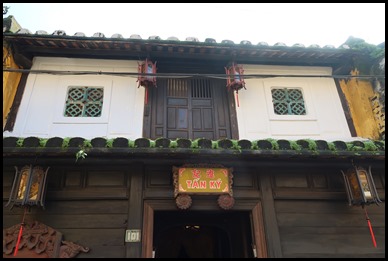 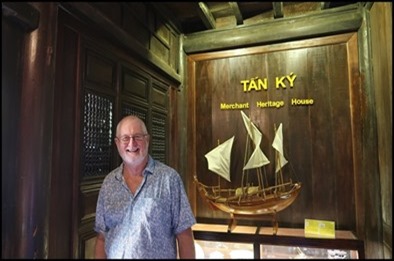 We stepped into Tan Ky House.
On
the notice board beside Bear were sheets telling of the Architecture of the
house and its History, they read as follows:
The
Tan Ky House traded in agricultural products in the 18th and 19th centuries, Its
owners had boats sail up the Thu Bon River and buy and carry the products home.
Goods ready for sale were kept in the ground floor; those to be sold later were
moved upstairs by means of pulleys. Its customers consisted of local and foreign
merchants who came mainly from South-East Asia and
Europe.
About
the end of the 18th century, thanks to the rapid
development of local business, the owner was able to rebuild the house on its
own base as we can see today. Generation after generation, the Tan Ky family has
made untiring attempts to keep the house in good condition, despite time and
weather. The name Tan Ky
came from the second generation, which means
“Progress Shop”. It expresses the owner’s wish for a prosperous business.
The Thu Bon River gradually silted up due to continuous floods and this made it
impossible for big ships to enter the port. This is one of several reasons for a
recession that started in the early 19th century. By the beginning of the 20th
century, very few ships from other parts of the world came to Hoi An and the
town ceased to be one of the mot important business centres of the
region.
Until now, the house has been the home of
seven generations of the same family. It offers evidence of the period when
trade with foreigners flourished in this important port from the 18th century to
the first half of the 19th century, a time when wealthy merchants built such
imposing houses.
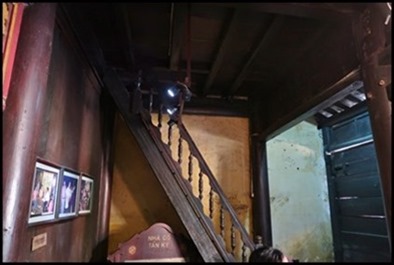  At the bottom of the
steep staircase (the wood looked
amazing for its age) was a sign that read:
Tan Ky shop-house was built by a Chinese in the late 18th century. It is one
of the most beautiful architectural projects in Hoi
An. The house has two two-storey
apartments connecting the front and the back streets. The front house looking to
Nguyen Thai Hoc Street served as a shop whereas the rear house faced Bach Dang
Street, also the riverbank, so convenient for loading and unloading commodities.
The interior of the house was divided into functioning parts: worship, business
doing, guest receiving, commodity storage, family activities.... Carvings on the
wooden beams, rafters, pillars in the house are very refined and excellent. The
precious antiquities of the house can, to some extent, prove the prosperity of
the former Tan Ky shop-house in particular and Hoi An in general. The house is
now one of the laces of interest of many VIP’s, both domestically and
internationally.
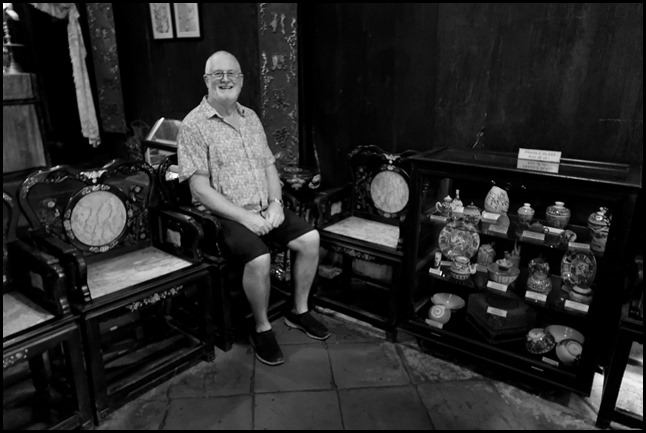 Bear waiting for his cup of tea,
sitting grandly in the reception room.
 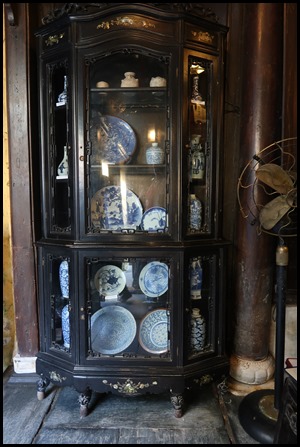  Bear, tea in hand.
A glass cabinet filled with antique
plates and superposed beams in
ironwood.
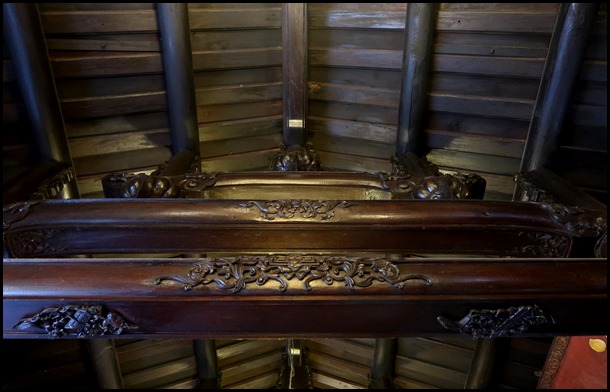 The stunning ceiling.
 A cross
section of the Tan Ky House.
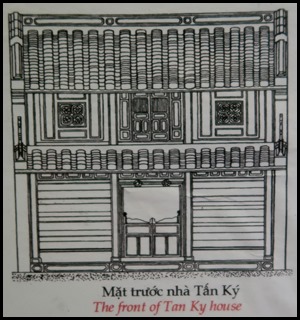 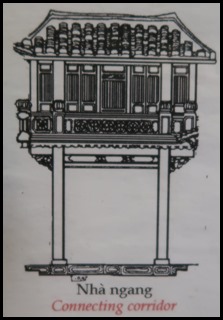 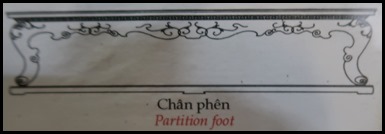 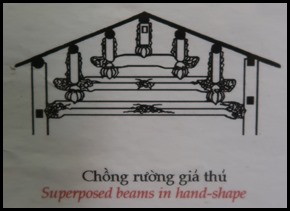   Design
features of the house.
Architecture: The design of the Tan Ky house shows the cultural
influences that Chinese and Japanese styles had on local architecture at that
time. The beams and roofs and ceilings, for example, are typical of these
architectural styles.
Although suffered from the devastation of time and floods, the house
has remained almost unchanged thanks to the good materials it was built with.
The inside wooden framework is joined with wooden pegs and rests on marble
bases. The outside structure is made of thick bricks and tiles, This design
helps to keep the house cool in summer and warm in
winter.
Many of the building materials were brought from other areas of
Vietnam. The paving stones and floor tiles, for example, come from Northern
areas. The old furniture and works of art in the house are typical of the
period, many are original.
The Tan Ky House has been listed in the top category of old houses by
the National Ministry of Culture. It has been filmed and shown on television and
become the best known and most visited house in Hoi An since
1983.
The house has the honour of receiving thousands of visitors every
year. It is the only one in Hoi An visited by international and Vietnamese
leaders such as Secretary General Truong Chinh, Secretary General Le Kha Phieu,
President Tran Duc Luong, Prime Minister Phan Van Khai, President Jiang Zemin
(China), Prime Minister Thaksin Shinawatra (Thailand)
etc.
 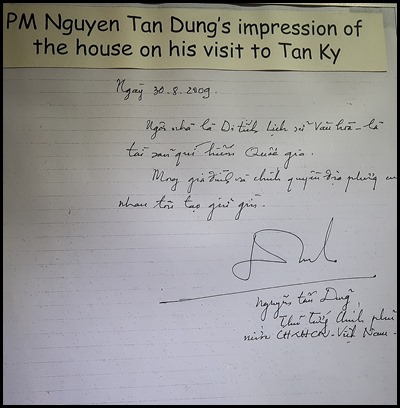 In pride of place – Greetings from the State President of Vietnam for the 1996
traditional New Year and a visit note from the Prime
Minister in 2009.
 A Translated
Excerpt from the Stele at the Grave of Le Tan Ky, the builder of Tan Ky
Merchant Heritage House.
Born an orphan at a very early
age, luckily, the poor little boy, Le Tan Ky, was brought up by his uncle Truong
and soon became a well-known, independent-minded young man living in Minh Huong
commune. He owned vast ricefields, gardens and farms with horses. The richer he
became, the more generous he became. He was always ready to share food and drink
with friends who frequently came to stay with him.... He was always always ready
to help anyone, including his workers and peasants in need, no matter how much
it might cost him....
After the age of sixty, he asked
his eldest son to take over his business and moved to Thu Bon village (Duy Xuyen District, Quang Nam
Province) where he lived amongst nature, moonlight and trees, avoiding trivial
things. He considered this the most pleasant way of life....
At the news of his death, many
poor peasants cried and said “Since Tan Ky’s arrival, we’ve been treated well
and eaten well. Thanks to his virtue, we’ve had neither floods nor droughts for
many years.... Whenever we wanted to block a cave or widen a stream, he always
helped us with rice and corn. Such a man of virtue we have never seen in our
lives.” Reported by Regent Nguyen Thien
Quan.
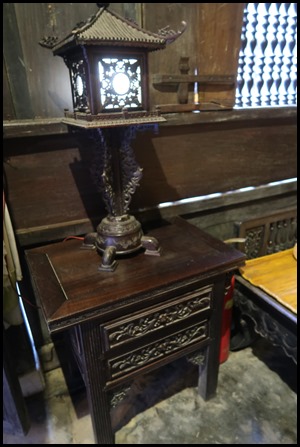 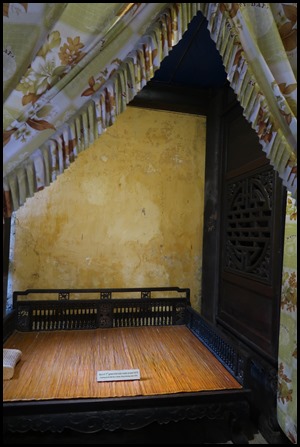  Bedside table
with lantern, bed of third
generation lady made around 1878, with air panels head and foot end.
Prayer shelf.
 A small shop in the back corner.
  Out in the lean to
were these farming tools, they were used
after harvest between 1950 and 1972, when the family donated all their
ricefields to peasants under the scheme of the then government “Peasants Own
Their Land”.
Nia: a large flat
winnowing basket.
Sang: a flat bamboo
woven basket used for the separation of different types of grains.
Du’ng: a bamboo woven
basket with holes large enough for small or broken grains to pass through but
bigger grains do not.
Thung: a deep bamboo
basket for holding rice.
Rice Huller: several human-powered rice hullers
similar to this last one were used to remove the chaff of the grains, the
family’s peasants used this one until the middle of the 20th
century.
 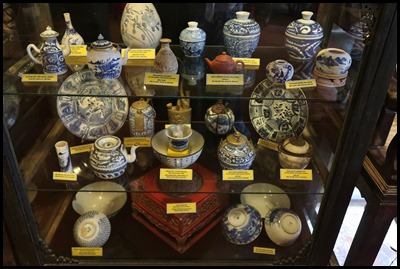 Our house tour
over, we could potter through more slowly, we began with the china displays. In the second cabinet an interesting little cup sat in the centre of the middle
shelf.
 Known as a
‘greedy cup’, this 16th century china piece was made in Fujian, China. It is
called the Cup of Confucius and has a small hole in
the bottom, if you fill it to eighty per cent all is well, if you fill it any
more all the contents leak out.
 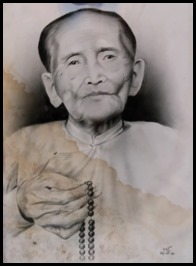 The next cabinet held an interesting
story. The lighting was awful so we had to take a picture straight on. The top
shelf held a picture and a written card standing behind a tortoiseshell box and a betel spittoon, part of an areca
set given to Ms Thai thi Lan, the third Tan Ky House
owner. The set was a gift from Dr. Pham Tuan on her 60th birthday in 1917.
Dr. Pham Tuan is an eminent
figure of the Five Flying Phoenixes, a phrase denoting the five successful
doctorate candidates from Quang Nam Province who attained their degree at the
same time. Dr. Pham Tuan’s daughter, Pham thi Thuan, became Ms Thai thi Lan’s
daughter-in-law in 1908 and she had four children, of whom the eldest son, Le
Hien (1910-1986), was an excellent student of Buoi High School (also called the
College du Protectorate). Always first in his class, he passed the graduation
exam with high distinction. He also won the King’s scholarship to study in
France in 1933. He was awarded a doctorate degree and later became the founder
of Le Pacific, a journal, and a consultant for the Vietnam Delegation at the
Franco-Vietnam Fontainebleau Conference (1946). He was also among the few
Vietnamese who took part in the compilation of the Larousse
dictionary.
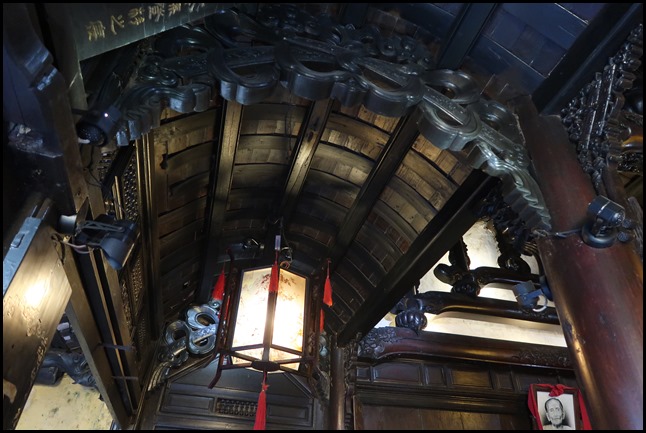 Gorgeous
ceiling with a little bit of Ms Thai thi Lan’s
portrait.
 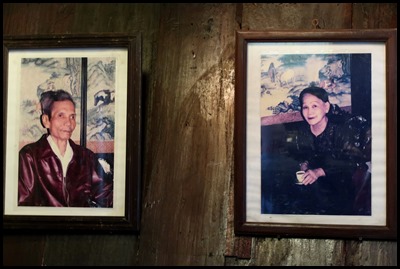 Near the front
entrance Chinese lettering and portraits of the 5th
generation owners of the house.
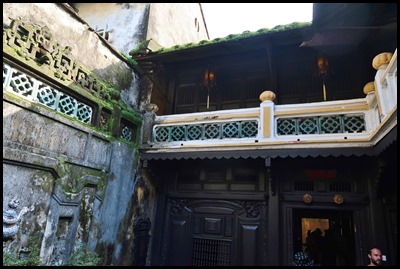 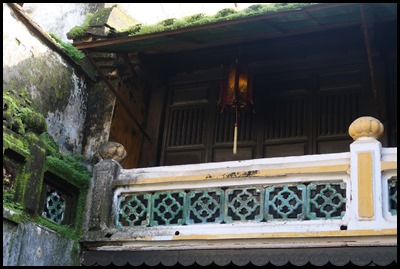 Standing in the connecting corridor
and looking up, we see the moss on the side wall,
wonder just how damp it is on the second floor where the
family live.
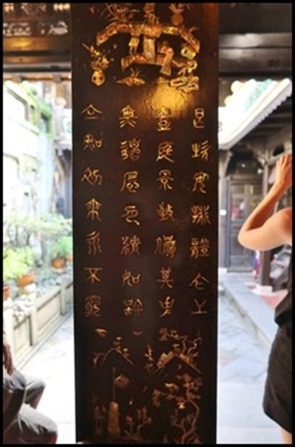   Inlay in one of the ironwood pillars, a bird pattern on another.
Mother of Pearl inlay on a table.
 Coffee table and
chairs.
 Bear stands beside yellow markers
with dates showing water levels during various floods and
typhoons. The top three read: 30th of September 2009, 12th of November
2007 and the 5th of November 2017.
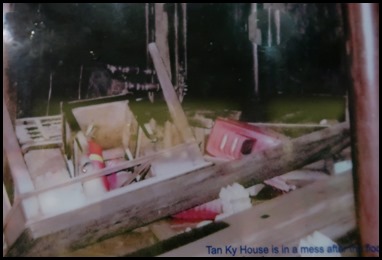 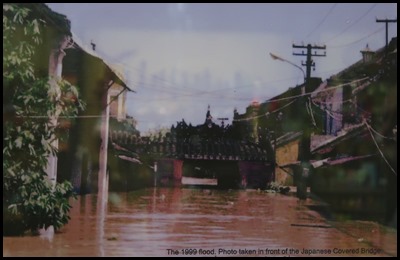 Tan Ky House in a
mess after a flood. The 1999 flood. Picture
taken in front of the Japanese Covered Bridge.
   1964 flood,
2007 flood and a boy rescuing his
dog.
 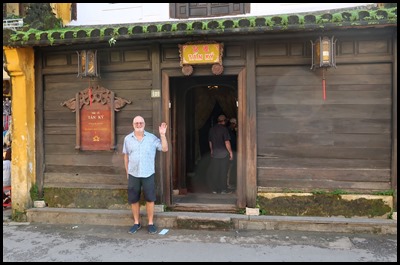 Tan Ky House during the flood of 2013 and Bear standing
outside today – the water level rose to just above Bear’s
elbow.
ALL IN ALL AN ELDERLY
GEM
A WELL PRESENTED AND VERY OLD HOUSE SO REGULARLY UNDER
WATER |